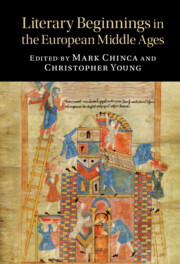Book contents
- Literary Beginnings in the European Middle Ages
- Cambridge Studies in Medieval Literature
- Literary Beginnings in the European Middle Ages
- Copyright page
- Contents
- Contributors
- Acknowledgments
- Foreword
- Chapter 1 Introduction
- Chapter 2 Scandinavia
- Chapter 3 Irish and Welsh
- Chapter 4 English
- Chapter 5 Spain
- Chapter 6 French
- Chapter 7 Dutch
- Chapter 8 Occitan
- Chapter 9 German
- Chapter 10 Italian
- Chapter 11 Czech and Croatian
- Chapter 12 Greek
- Chapter 13 East Slavonic
- Afterword
- Index
- Cambridge Studies in Medieval Literature
Chapter 11 - Czech and Croatian
Published online by Cambridge University Press: 11 August 2022
- Literary Beginnings in the European Middle Ages
- Cambridge Studies in Medieval Literature
- Literary Beginnings in the European Middle Ages
- Copyright page
- Contents
- Contributors
- Acknowledgments
- Foreword
- Chapter 1 Introduction
- Chapter 2 Scandinavia
- Chapter 3 Irish and Welsh
- Chapter 4 English
- Chapter 5 Spain
- Chapter 6 French
- Chapter 7 Dutch
- Chapter 8 Occitan
- Chapter 9 German
- Chapter 10 Italian
- Chapter 11 Czech and Croatian
- Chapter 12 Greek
- Chapter 13 East Slavonic
- Afterword
- Index
- Cambridge Studies in Medieval Literature
Summary
The ancestors of modern Czechs and Croats encountered literacy in Old Church Slavonic, but having fallen into the orbit of the Western Church embraced the literary culture of Latinate Europe. Yet, caught between Latin and Church Slavonic, these communities made different choices. The Czechs relinquished Church Slavonic and developed literature in Latin, a foreign learned language. The Croats, while accepting the dominance of Latin in the literary sphere, nevertheless, managed to preserve Church Slavonic and create their own variant of literary language and writing in Glagolitic, which they used in liturgy on a par with Latin. These choices were crucial in determining how literatures in the vernacular emerged and took shape in Bohemia and Croatia. By contrasting these two literary itineraries, the chapter revisits the question of how we study and piece together a literary history, how we understand the concept of a ‘national literature’, and whether this concept should hinge exclusively on the vernacular that corresponds to the modern standard language. Central to the approach is Iurii Lotman’s model of literary traditions as dynamic semiotic cultural systems, in which cultural change results from the coexistence and interaction of two processes of human activity: cultural evolution and explosion.
Keywords
- Type
- Chapter
- Information
- Literary Beginnings in the European Middle Ages , pp. 228 - 254Publisher: Cambridge University PressPrint publication year: 2022

